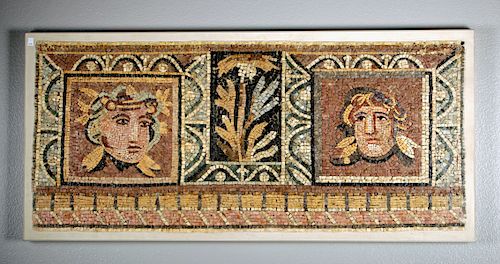Roman Stone Mosaic - Two Theater Masks & Botanical
Lot 66
About Seller
Artemis Fine Arts
686 S Taylor Ave, Ste 106
Louisville, CO 80027
United States
Selling antiquities, ancient and ethnographic art online since 1993, Artemis Gallery specializes in Classical Antiquities (Egyptian, Greek, Roman, Near Eastern), Asian, Pre-Columbian, African / Tribal / Oceanographic art. Our extensive inventory includes pottery, stone, metal, wood, glass and textil...Read more
Estimate:
$18,000 - $25,000
Absentee vs Live bid
Two ways to bid:
- Leave a max absentee bid and the platform will bid on your behalf up to your maximum bid during the live auction.
- Bid live during the auction and your bids will be submitted real-time to the auctioneer.
Bid Increments
| Price | Bid Increment |
|---|---|
| $0 | $25 |
| $300 | $50 |
| $1,000 | $100 |
| $2,000 | $250 |
| $5,000 | $500 |
| $10,000 | $1,000 |
| $20,000 | $2,500 |
| $50,000 | $5,000 |
| $100,000 | $10,000 |
| $200,000 | $20,000 |
About Auction
By Artemis Fine Arts
Feb 21, 2019
Set Reminder
2019-02-21 10:00:00
2019-02-21 10:00:00
America/New_York
Bidsquare
Bidsquare : Exceptional Antiquities, Asian, Ethnographic
https://www.bidsquare.com/auctions/artemis-gallery/exceptional-antiquities-asian-ethnographic-3858
An important one-day auction featuring museum-worthy examples of Egyptian, Greek, Roman, Etruscan, Near Eastern, Far East / Asian, Pre-Columbian, African / Tribal, Oceanic, Native American, Spanish Colonial, Russian, Fossils, Ancient Jewelry, Fine Art, so much more! Artemis Fine Arts info@artemisfinearts.com
An important one-day auction featuring museum-worthy examples of Egyptian, Greek, Roman, Etruscan, Near Eastern, Far East / Asian, Pre-Columbian, African / Tribal, Oceanic, Native American, Spanish Colonial, Russian, Fossils, Ancient Jewelry, Fine Art, so much more! Artemis Fine Arts info@artemisfinearts.com
- Lot Description
Roman, the Levant, late Imperial Period, ca. 3rd to 4th century CE. A spectacular mosaic comprised of square stone tesserae depicting the faces of two theater masks looking toward one another and set in square frames that are surrounded by decorative borders, with a blossoming plant in the panel between them. All is skillfully rendered in a vibrant color scheme of sienna, beige, gold, seafoam green, peach, wine red, black, grey, russet, yellow ochre, and white. Each visage presents naturalistically features, and both are finely delineated so as to provide a sense of three dimensionality. Leafy wreaths crown their mesmerizing visages. Surrounding the entire composition is a marvelous decorative egg and dart border that provides not only additional color but also a sense of depth to the piece. There is also a lower border of pink and yellow cubes with white edges seen in perspective on a red ground. Size: 41.25" W x 19.25" H (104.8 cm x 48.9 cm) including the matrix
Mosaics (opus tesellatum) are some of our most enduring images from the Roman world, exciting not only for their aesthetic beauty, but also because they reveal what Romans chose to depict and see every day decorating their private and public spaces. As in Greece, masks played an important role in Roman theatre. An actor's entire head and hair would be covered by a large mask of simple design, made from linen or cork, with holes for the mouth and eyes. These masks allowed audience members seated in all areas of the theatre to understand what was happening, while also amplifying the actor's voice. The Pompeiian mosaic from the House of the Tragic Poet (now in the Naples National Archaeological Museum) shows several examples of these masks including one actor wearing an example pushed up on his head.
In the Roman province of Syria, which encompassed most of the ancient Near East/Levant, mosaics developed as a common art form relatively late, with most finds coming from the 3rd century CE or later. Syria was one of Rome's wealthiest provinces, but it was also far removed from Rome itself and Roman culture was overlaid on enduring cultural traditions from Hellenistic Greece and the great civilizations that came before it. Antioch-on-the-Orontes (modern day Antakya, Turkey), was the capital of northern Roman Syria, and its excavations in the 1930s revealed more than three hundred mosaic pavements - of which many embellished public baths. Popular mosaic themes from this region were often mythological or religious scenes, depicting gods and goddesses; however, sometimes mosaics were created to fit the theme of a building or room. This example may have been intended for a theatre. Romans appreciated all forms of entertainment and there were hundreds of playwrights in ancient Rome. Plays were performed to honor the gods during religious ceremonies, and since Rome had over 200 religious days of commemoration each year, plays were performed many days of the year.
Cf. a border from Room 2 in the House of the Mysteries of Isis at Antioch, now in Hartford, illustrated in Doro Levi, "Antioch Mosaic Pavements" (Princeton, 1947), pls. 33 c & 102 f-g, and a border from Room 8 in the House of the Boat of Psyches at Antioch, now in Baltimore, also illustrated in Doro Levi, pl. 42 a.
Provenance: private East Coast, USA collection; ex William Froelich Collection, New York, New York, USA, 1970s
All items legal to buy/sell under U.S. Statute covering cultural patrimony Code 2600, CHAPTER 14, and are guaranteed to be as described or your money back.
A Certificate of Authenticity will accompany all winning bids.
We ship worldwide and handle all shipping in-house for your convenience.
#141964This mosaic is in remarkable condition. There are some chips/fissures to tesserae, normal areas of encrustation, but very few losses. Set in modern matrix with metal frame.Condition
- Shipping Info
-
All shipping is handled in-house for your convenience. Your invoice from Artemis Gallery will include shipping calculation instructions. If in doubt, please inquire BEFORE bidding for estimated shipping costs for individual items.
-
- Buyer's Premium



 EUR
EUR CAD
CAD AUD
AUD GBP
GBP MXN
MXN HKD
HKD CNY
CNY MYR
MYR SEK
SEK SGD
SGD CHF
CHF THB
THB
















